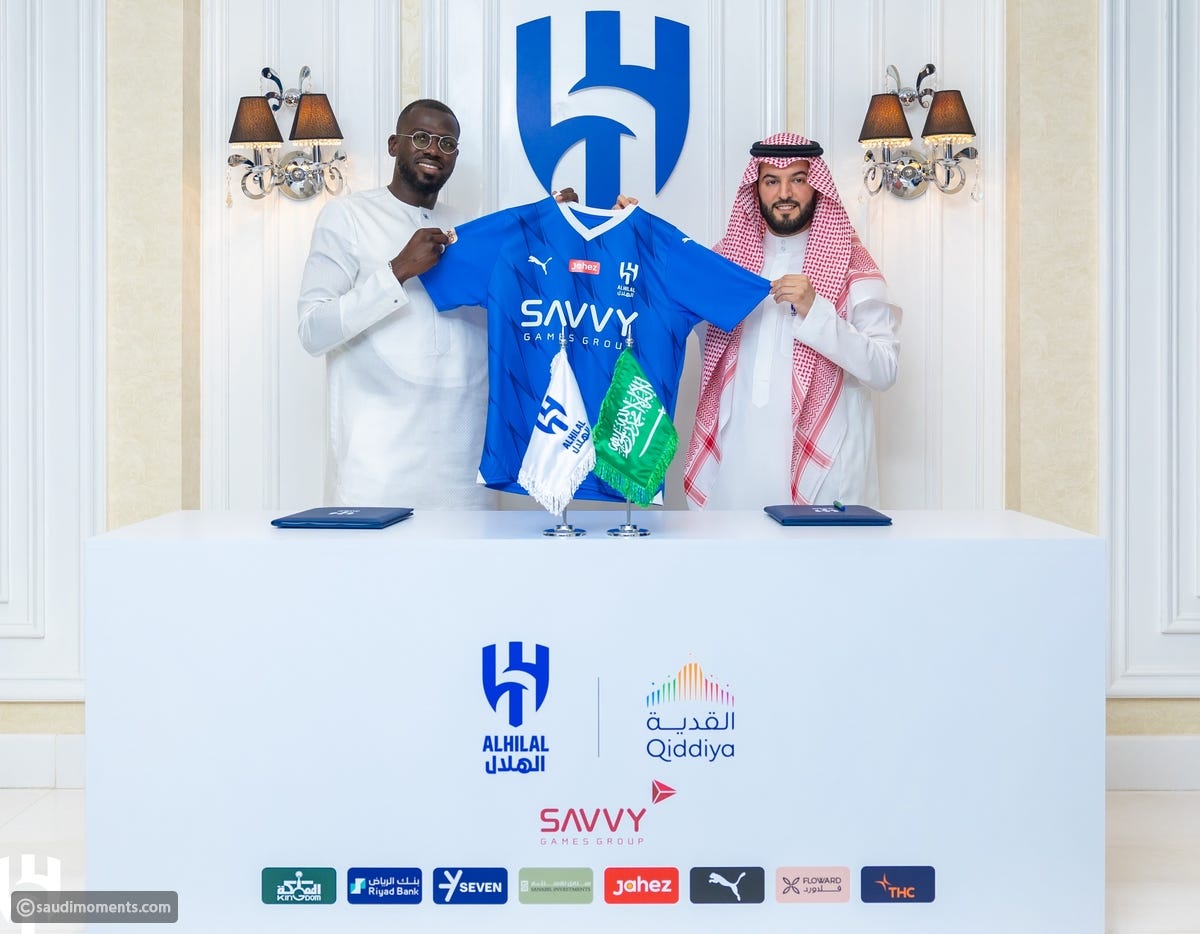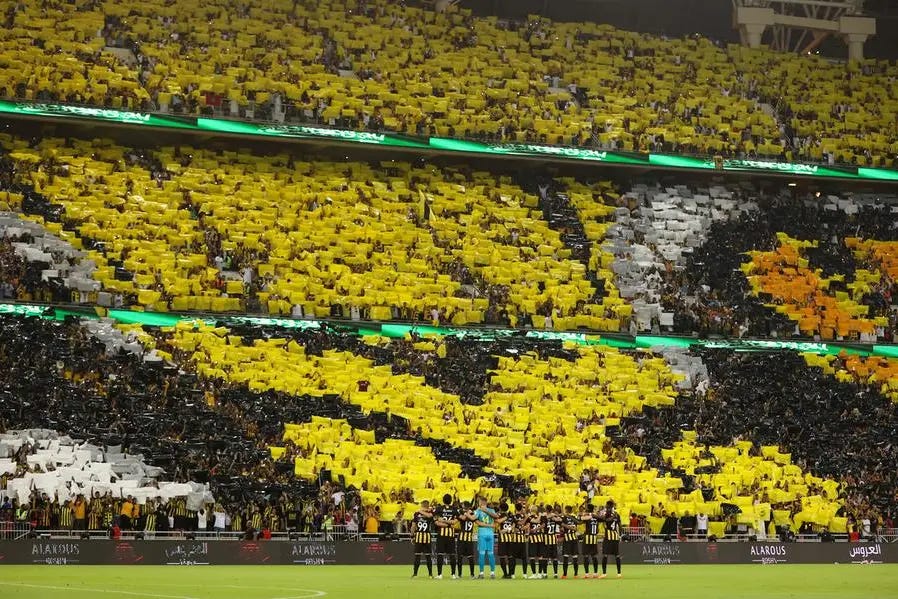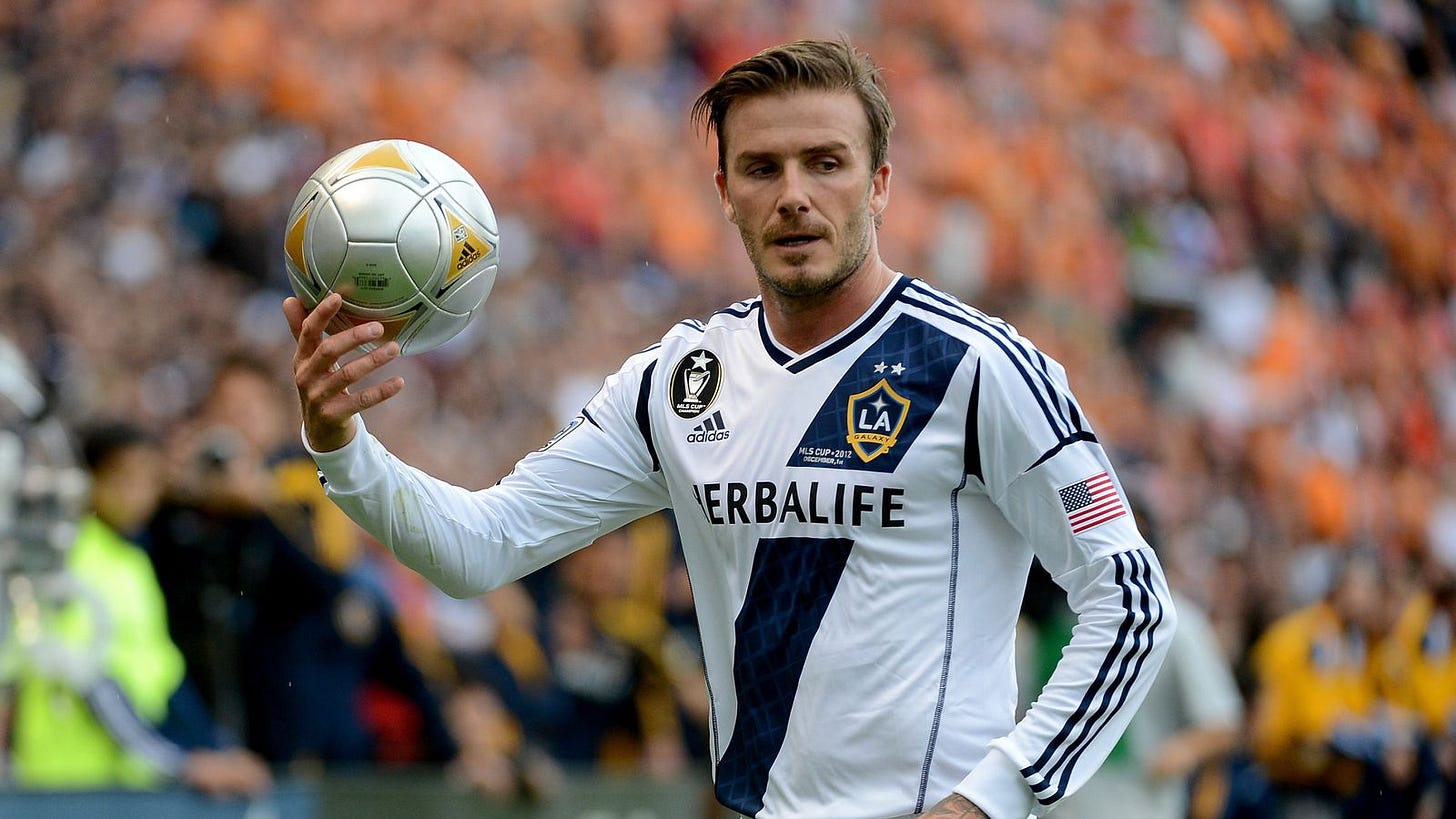Buyers: How the Saudi Pro League is Changing World Soccer
On the Saudi interest in sports, how the SPL is following an MLS blueprint, and why it's going to change how your favorite club buys players.
In the summer of 2023, following decades of success, Chelsea Football Club had just finished in 12th place in the English Premier League, their worst result since 1994. The owner who had presided over the club’s rise to Europe’s elite in the early 2000s, Russian oligarch Roman Abramovich, had been forced to sell the club after England levied sanctions against him due to Russia’s invasion of Ukraine.
The buyer was Todd Boehly, an American billionaire with no prior experience in soccer. In the first few months of his ownership, that inexperience showed. The Ted Lasso comparisons came early and often. Chelsea made several huge signings in his first year that produced little value on the field.
Consequently, the club’s finances were in shambles. Chelsea’s net spend (the amount of money made from selling players minus the amount spent buying players) across the first two windows of Boehly’s reign was -$608m. That was the largest transfer deficit across the soccer world - more than twice that of the next biggest spender.
Chelsea was in grave danger of violating Financial Fair Play rules, salary cap-like restrictions established by the European soccer governing body, UEFA. The club desperately needed a good return from player sales in 2023 to avoid sanctions. Optimism was not high. Given Boehly’s record of overpaying for transfers throughout his first season, few believed he could, for any respectable fee, sell the down-trodden, out-of-form players that had begun to make up the bulk of Chelsea’s lineup.
And then, somehow, he did.
Chelsea started by offloading two disgruntled midfielders, Mason Mount and Kai Havertz, to rival Premier League clubs for a combined $131m. They followed by sending Christian Pulisic and Ruben Loftus-Cheek to AC Milan for another $39m. All four of these players represented relatively young prospects who may still have their best days ahead of them, justifying the hefty fees.
Then things got weird. On July 1st, Chelsea announced the sales of 31-year-old goalkeeper Édouard Mendy and 32-year-old center back Kalidou Koulibaly to two teams in the Saudi Pro League for a combined $45m.
Chelsea fans couldn’t believe their luck in offloading the pair for such a large fee. The rest of the world was left scratching their heads. Soccer players generally peak between the ages of 25 and 28. Both Koulibaly and Mendy had at one time been among the best in the world at their position, but were now past their prime and rapidly declining in ability. Why had the Saudi Pro League, known mainly for the rogue acquisition of Ronaldo this past January, just broken the bank for two players who were old and quickly declining?
The Saudi spending spree went far beyond Chelsea. Manchester City just announced a move for 32-year-old Riyadh Mahrez to Al-Ahli for $39m. Inter Milan offloaded 30-year-old Marcelo Brozović to Al-Nassr for $20m. Liverpool sold a 29-year-old Fabinho (the spring chicken of the bunch) to Al-Ittihad for $52m, and 33-year-old England captain Jordan Henderson is on the way to Al-Ettifaq for a contract rumored to be around $46m a year. More huge names like Karim Benzema (35, $110m/year), N’Golo Kanté (32, $95m/year), and Roberto Firmino (31, $22m/year) signed extremely lucrative contracts in the Saudi league after becoming free agents.
These transfers, which alone seemed like an indiscriminate spending spree by the Saudis, together paint a fascinating picture. Saudi Arabia, through the Saudi Pro League, is going all-in, but they aren’t following any kind of traditional transfer strategy to do it. However, when we look into the forces underlying the Saudis’ big-money foray into soccer, the methodology, and eventual effects begin to come into focus.
Understanding the SPL
To understand the mass migration to Saudi Arabia, let’s start by taking a closer look at the Saudi Pro League. The SPL was founded in 1976, making it one of the older leagues in world soccer. It has 18 teams, with a traditional round-robin, promotion-relegation system like the big European leagues.
Despite a misconception that the SPL is a startup league that was born this year with the arrival of Ronaldo, the SPL has been relevant in the soccer world for a long time. Soccer is by far the most popular sport among the 35 million Saudis, and the SPL has already established itself as the top league in Asia, sitting just above Japan and South Korea’s domestic leagues in the Asian Football Conference coefficient. The league’s biggest rivalry, the “Saudi El Clásico,” between Al-Ittihad and Al-Hilal, rivals the intensity of some of the soccer world’s fiercest contests: think Barcelona vs. Real Madrid, United vs. Liverpool, and for my American football readers, Bears vs. Packers.
The SPL began attracting global attention when Al-Nassr signed 37-year-old Cristiano Ronaldo to a contract worth around $200m annually. The deal came just after a highly successful World Cup in Qatar, which, much like Saudi Arabia, is a Gulf nation with a growing interest in sports. It also came at a time when LIV Golf, a venture backed by the Public Investment Fund (PIF), a Saudi government-run wealth fund, was making waves as it signed players away from the PGA Tour by offering them massive contracts.
At the time of his signing, Ronaldo’s move seemed like a way for him to cash in on a career that was fading. He was a bit player at Manchester United last fall and was relegated to the bench in Portugal’s World Cup run. Ronaldo became the only notable player in the SPL after his signing, and there wasn’t any reason to believe that the move was anything more than a publicity stunt by the Saudis to bring positive attention to the SPL.
Then in June, the PIF made a big splash that signaled Saudi Arabia’s larger ambitions in soccer. The PIF purchased a 75% stake in each of the SPL’s “Big 4.” These clubs - Al-Hilal, Al-Nassr, Al-Ahli, and Al-Ittihad - generally sit at the top of the table, have the most fans, and sign the most prominent players. Through this investment, the PIF now had complete operational control of all four of them.
Immediately following this PIF investment was the buying spree that saw these four clubs offer massive contracts and transfer fees to players across Europe. Any doubts that targeted players had about moving from England or Italy to Saudi Arabia were quickly put to rest by wages up to ten times larger than their original salaries.
But as we noted earlier, these purchases were also of a peculiar variety. The Saudis were not necessarily investing their massive capital into the best players in the world; they were trying to buy the biggest names. It’s the kind of move you would intuitively think a growing league should avoid - buying a quickly depreciating asset at a premium price. However, looking to history for a precedent, we see that the Saudi approach looks similar to another big-money push from a previously little-known league.
Why the old guys?
In early 2007, Real Madrid and David Beckham were at a crossroads. Beckham, one of Madrid’s Galácticos signings of the early 2000s, regularly watched games from the bench as Madrid limped out to a poor start in the 2006-2007 campaign. Still one of the game’s biggest stars, Beckham was rumored to be on the move at the end of the season.
Beckham ended the suspense on January 11th when he announced that he had signed a five-year deal with Major League Soccer’s Los Angeles Galaxy. The response across the soccer community was something between shock and outright anger. Why would a player of Beckham’s quality, an icon of the sport, ever consider a move to a country where soccer was an afterthought? Days after Beckham’s announcement, Real Madrid's president said that Beckham was, “Going to Hollywood to be half a film star,” adding, “Our technical staff was right not to extend his contract, which was proved by the fact that no other technical staff in the world wanted him other than Los Angeles.”
The MLS was an unlikely destination for Beckham. Although it would see spikes in interest every four years when the World Cup came around, the league's finances and reputation were often in flux. The MLS realized it needed to expand its base at home to a more casual viewer while also bringing legitimacy to a league that wasn’t taken seriously abroad. Enter Beckham. As Timothy Leiweke, former CEO of the LA Galaxy, put it, “David is truly the only individual that can build the bridge between soccer in America and the rest of the world.” Leiweke compensated Beckham accordingly, with a contract worth $32m a year, plus a clause from the MLS that Beckham could one day purchase an expansion team for $25m.
And Beckham delivered. He simultaneously raised popularity domestically and respect internationally for the league. Major League Soccer has flourished since his arrival, expanding from 13 teams in his debut season to 29 teams today. Aging stars like Thierry Henry, Zlatan Ibrahimović, Andrea Pirlo, and Steven Gerrard followed Beckham’s lead across the Atlantic, signing extremely lucrative contracts in exchange for their celebrity profiles. These signings' impact on the growth of the league was enormous. The league’s TV rights deal, which makes up most of its income, went from $75m in 2007 to $2.5b with Apple this past year. Oh, and Beckham did finally get around to exercising that MLS expansion clause. He founded Inter Miami, which you may know as the club that just brought Lionel Messi to the United States.
When Al-Nassr signed Cristiano Ronaldo this January, he became the Saudi Pro League’s David Beckham. Similarly to the MLS, the Saudi Pro League is building itself from the top down, buying huge names that will quickly bring a large following and a sense of sporting legitimacy to the league. The SPL recognizes, just as the MLS did, that even though these stars are past their prime in terms of performance, what they offer in commercial appeal is more important to the league's growth.
However, the Saudis are executing this blueprint much faster and on a much larger scale. Whereas the MLS was limited by the amount that individual owners were willing to spend on big names, and how quickly that investment would pay off for their club, the SPL’s backing from the PIF has allowed it to amass a group of stars in eight months that rivals what the MLS has attracted over 15 years. It has taken a massive level of investment to bring all these players to Saudi Arabia, a larger investment than the PIF could hope to recoup via a TV deal or ticket sales any time soon. However, the PIF’s enormous wealth affords it the ability to adopt a long-term vision, even longer than the billionaire owners in the MLS. In fact, the goal of the Saudi sports venture may be worth far more to them than any future sporting returns.

Behind Saudi Arabia’s new interest in sports - including investments in Formula One, Boxing, WWE, the UFC, and LIV Golf, which recently announced a merger with the PGA - is a much more foundational shift in Saudi economic strategy. In 1938, an American-owned oil well struck the largest source of petroleum in the world in Dammam. Since then, Saudi Arabia has built their wealth almost exclusively on the export of this oil. Crown Prince Mohammed bin Salman (MBS), a young populist leader who came to power in 2017, has decided to diversify the economy amidst uncertainty in the future demand for oil. The Saudi “Vision 2030” plan asserts that a strong presence in sports is key to attracting foreign investment, increasing employment, and promoting tourism in Saudi Arabia. To MBS, the real payoff from the investment in sports might not come from ticket sales or a lucrative TV rights package, but from making Saudi Arabia a more attractive entity for tourists and investors from the West.
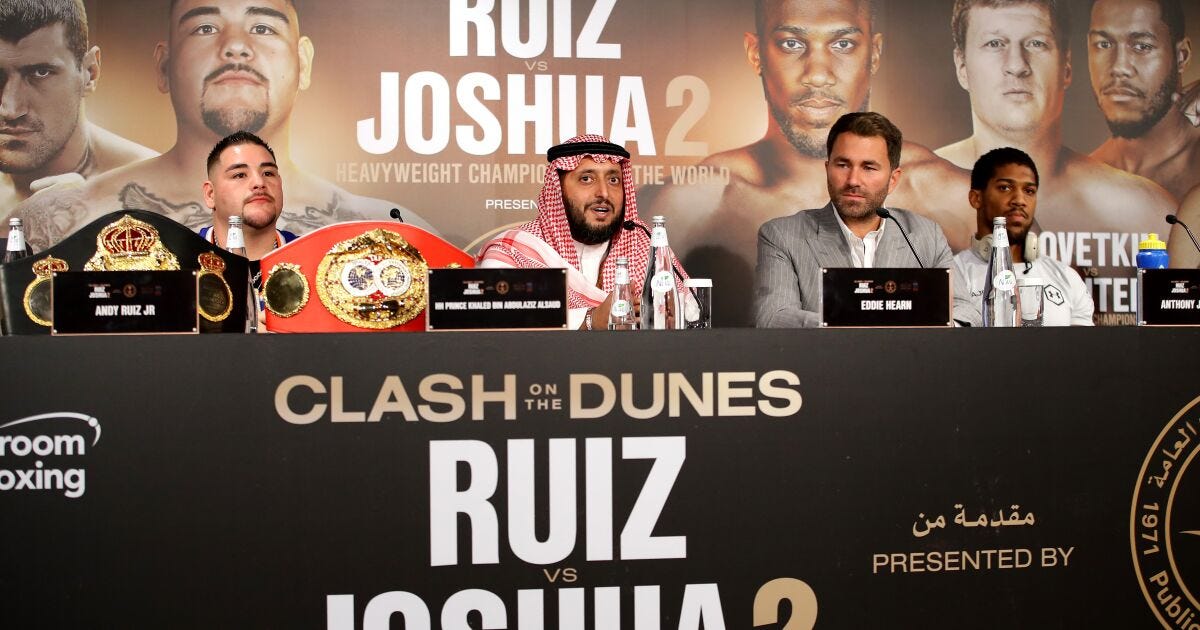
This strategy has not been without controversy. The Saudis’ approach has also been seen by many as “sports-washing,” using sports to distract from human rights abuses in the country. These assertions have support from notable experts, including Dr. Abdullah Al-Arian of Georgetown University in Qatar, who addresses the Saudis’ use of soccer in his book, Football in the Middle East: State, Society, and the Beautiful Game. MBS also infamously approved the murder and dismemberment of Jamal Khashoggi, a prominent Washington Post journalist who was critical of the Crown Prince. This put Saudi Arabia at odds with the United States, which, up until the murder of Khashoggi, had been one of its closest allies in the Middle East.
When we consider the goal of the Saudi foray into sports as one that hopes to improve the image of the country, it seems that both arguments - that the PIF’s work in sports is to diversify the economy and that it is sports-washing to repair its image - hold water. Both work towards the ultimate goal of legitimizing Saudi Arabia and strengthening a one-dimensional economy.
It is also worth mentioning how Saudi Arabia’s opening of its economy has led to a relative relaxation of some of its most conservative social stances. Here, The Athletic’s Wael Jabir reflected on the societal changes accompanying Saudi Arabia’s movement towards sport: “A big part of it is the diversification of the economy, but it’s also the transformation of society. That’s why I think sports and entertainment domestically help you move towards that ... We have seen genuine moves away from that conservative heritage with so many things, be it in terms of women being able to drive, women being able to go to stadiums, women’s participation in the workforce. ... I’m someone who was born in this country. I’ve seen how it was 20 years ago. I remember very much as a 10-year-old being chased by the religious police when it was prayer time and we were playing football. The religious police don’t exist anymore, so a lot of these things are genuine changes, and they are changes to a large extent that have been met with quite a positive response.”
The Effect on the Soccer Market
The motivations and domestic impacts aside, the investment into the SPL has made a huge impact on the global transfer market.
As with Chelsea selling their players to the Saudis, an interesting mismatch in incentives has created a symbiotic relationship between big European clubs and the Saudi Pro League. The chief motivation for big teams is to buy the best possible players to win the most games, as it yields prize money and lucrative TV opportunities. As we established earlier, the chief incentive for the Saudis is to buy the most famous players with the biggest following to grow the SPL brand.
Only one transfer window into this new Saudi reality, and we’ve already seen older players that clubs wouldn't have dreamed of being able to sell off get moved to Saudi at exorbitant prices. As the market begins to adjust, however, we can imagine how this new buyer might have an upstream effect on how big clubs approach their own purchases.
It used to be risky for a big club to pay a premium fee or extend a contract for a player around 28 or 29, out of fear that they may soon be out of their prime. However, Saudi Arabia’s willingness to buy older players reduces the risk for big clubs, as they know they have an effective insurance policy in shipping the players off to a PIF-backed Saudi team if their performance declines.
In addition to age, there is another intriguing aspect to the profile of players the Saudis have often been seeking: practicing Muslims. Of the 17 players to head to Saudi Arabia with a market value greater than €10m this summer, eight are Muslim. This is a huge proportion when you consider that Muslim players make up less than 10% of players in Europe’s Big-5 Leagues.
There are likely two factors at play here. The first is the preference of some of these players to play in Saudi Arabia. Saudi Arabia is the most culturally significant land in Islam and home to Mecca, where Muslims travel for pilgrimage. Kalidou Koulibaly, one of the Chelsea players offloaded to Saudi Arabia, noted when discussing his summer transfer, “I am a Muslim, I am coming to a country that is ideal for me and my family. Mecca is close, I will feel better because I am a believer, so it is important for me.” One of the hang-ups for many players approached to join the Saudi league is that many are not keen on moving to Saudi Arabia. High-profile Muslim players may be less likely to have those reservations.
The other factor is demand from within Saudi Arabia. As an Islamic nation, Muslim soccer players, such as Riyadh Mahrez and N’Golo Kanté, are wildly popular domestically. For Karim Benzema’s unveiling a few weeks ago, the King Abdullah Stadium in Riyadh was at its 62,000-person capacity. Bringing these players to Saudi Arabia is a surefire way to supercharge the domestic fan base and maintain these stars' status as high-profile Muslim players. Much as higher demand for older, more popular players may increase their price upstream at big European clubs, we may expect the same with high-profile Muslim players.
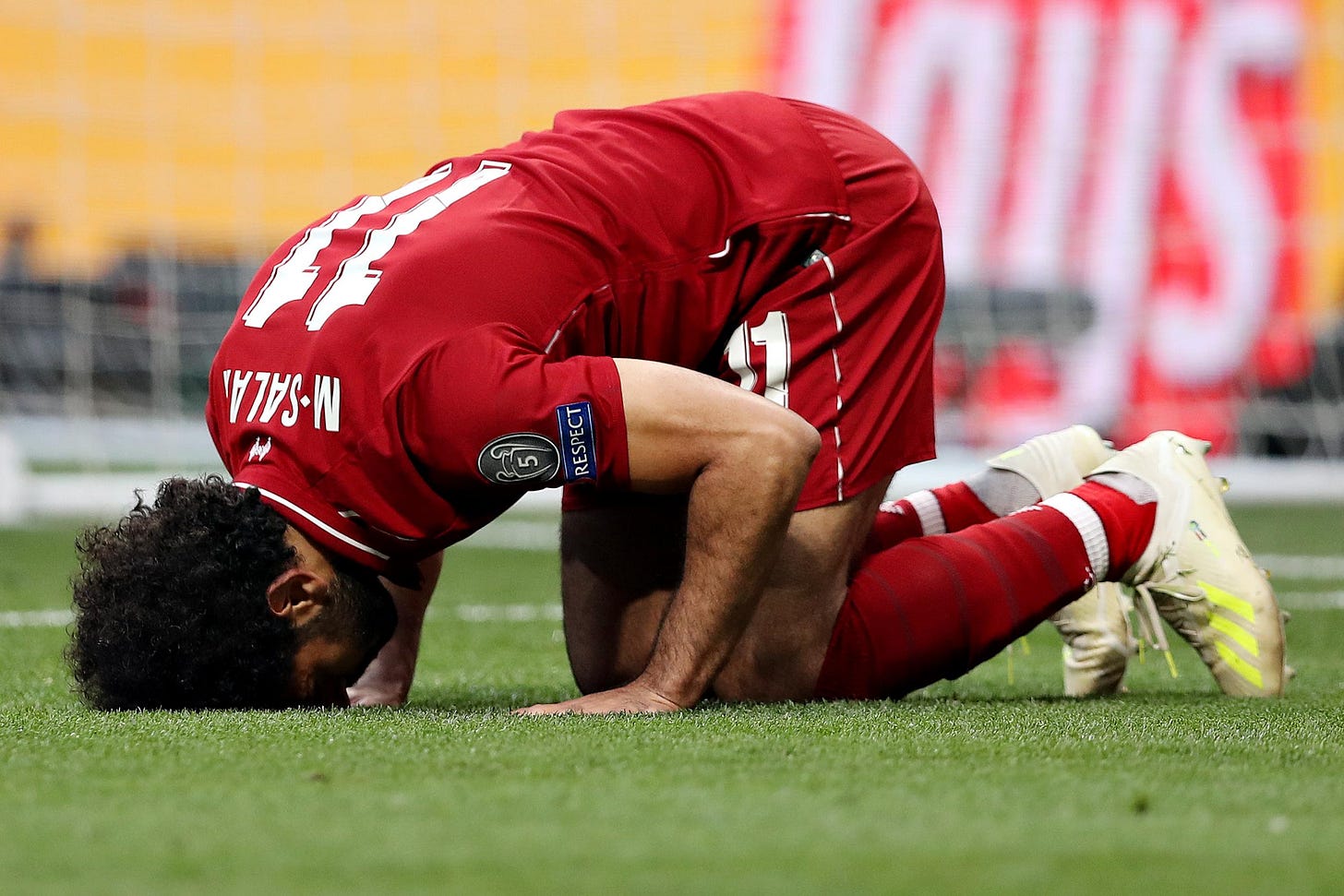
In 2022, before Saudi Arabia’s PIF-backed emergence into the market, Liverpool extended the contract of Mohamed Salah, the world’s most famous Muslim player, until 2025. It is a big money deal that keeps him at the club until he is 33, an extremely advanced age for a winger. If Chelsea’s sale of Mendy and Koulibaly, two older Muslim players, is any indication, it looks like that contract could land Liverpool a massive payday if they opt to sell Salah to an SPL club.
And what of the MLS? Before Messi decided to head to Inter Miami, he turned down an offer from Saudi Arabia reportedly worth $1.5 billion. Ronaldo, who ultimately joined the Saudi league, was a longtime target of the MLS. For years it was whispered across world football that the game’s greatest stars may play out their last chapter on American soil. Instead they diverge one last time, planting the seeds of an arms race, not for the top talent of today, but yesterday.
Enjoyed this post? like, subscribe, and share Game Theory with friends!
Edited excellently by Greta Gruber





